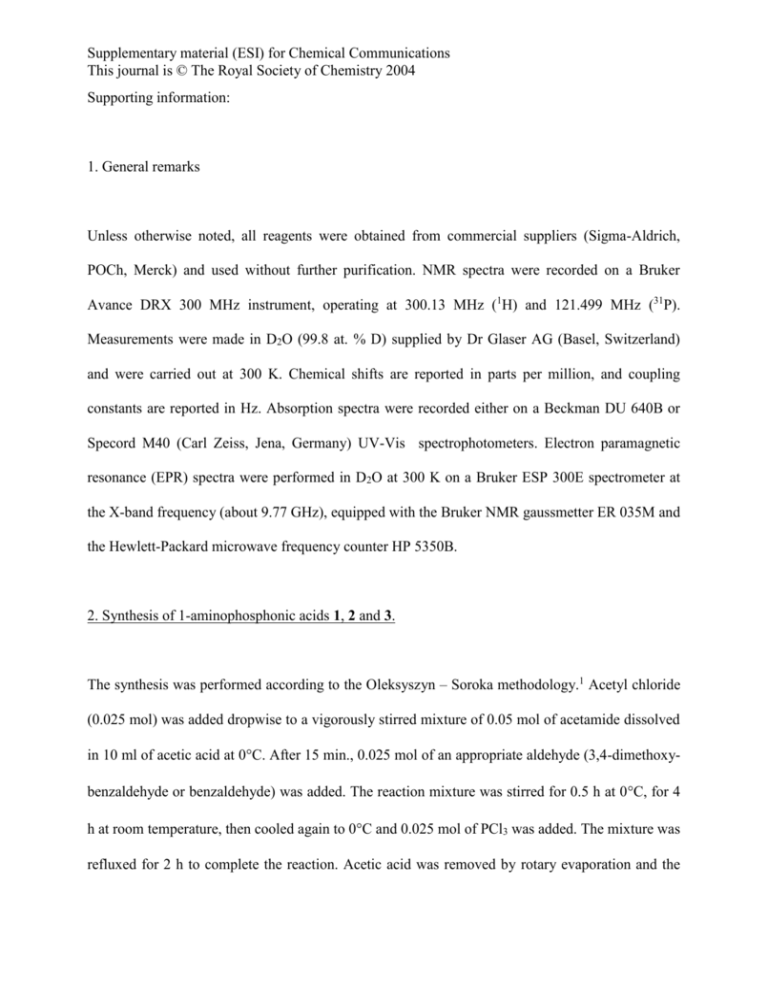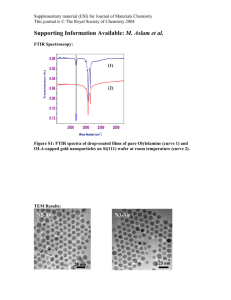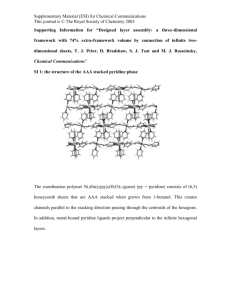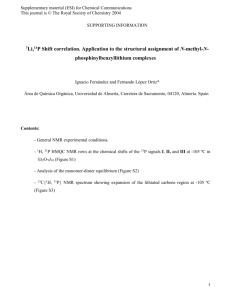Experimental details, NMR, EPR and UV
advertisement

Supplementary material (ESI) for Chemical Communications This journal is © The Royal Society of Chemistry 2004 Supporting information: 1. General remarks Unless otherwise noted, all reagents were obtained from commercial suppliers (Sigma-Aldrich, POCh, Merck) and used without further purification. NMR spectra were recorded on a Bruker Avance DRX 300 MHz instrument, operating at 300.13 MHz (1H) and 121.499 MHz (31P). Measurements were made in D2O (99.8 at. % D) supplied by Dr Glaser AG (Basel, Switzerland) and were carried out at 300 K. Chemical shifts are reported in parts per million, and coupling constants are reported in Hz. Absorption spectra were recorded either on a Beckman DU 640B or Specord M40 (Carl Zeiss, Jena, Germany) UV-Vis spectrophotometers. Electron paramagnetic resonance (EPR) spectra were performed in D2O at 300 K on a Bruker ESP 300E spectrometer at the X-band frequency (about 9.77 GHz), equipped with the Bruker NMR gaussmetter ER 035M and the Hewlett-Packard microwave frequency counter HP 5350B. 2. Synthesis of 1-aminophosphonic acids 1, 2 and 3. The synthesis was performed according to the Oleksyszyn – Soroka methodology.1 Acetyl chloride (0.025 mol) was added dropwise to a vigorously stirred mixture of 0.05 mol of acetamide dissolved in 10 ml of acetic acid at 0C. After 15 min., 0.025 mol of an appropriate aldehyde (3,4-dimethoxybenzaldehyde or benzaldehyde) was added. The reaction mixture was stirred for 0.5 h at 0C, for 4 h at room temperature, then cooled again to 0C and 0.025 mol of PCl3 was added. The mixture was refluxed for 2 h to complete the reaction. Acetic acid was removed by rotary evaporation and the Supplementary material (ESI) for Chemical Communications This journal is © The Royal Society of Chemistry 2004 oily residue was hydrolysed for 6 h in 8 M HCl. The crude mixture was evaporated under reduced pressure and the residue was dissolved in 100 ml of ethanol. Precipitated ammonium chloride was filtered off. The filtrate was treated with propylene oxide until pH reached 6. The precipitated 1aminophosphonic acid was filtered off, washed with ethanol and recrystalized from water. Deprotection of the methoxy groups was performed by refluxing 0.01 mol of the amino-(3,4dimethoxyphenyl)methanephosphonic acid 2 in 50 ml of HI for 6 h. Evaporation of the volatile products by means of rotary evaporator, followed by dissolving the residue in 50 ml of ethanol and precipitation with propylene oxide (pH = 6) gave the desired phosphonic acid 1, which was recrystalized from water-ethanol to gave the final product. Spectral and analytical data for 1aminophosphonic acids 1, 2 and 3 were identical with those published earlier. 2, 3 3. Experimental. 3a. Oxidation of amino-(3,4-dihydroxyphenyl)methylphosphonic acid 1 by NaIO4 in pH 3.5 - 5. Figure 1. 31P NMR spectra recorded 10 min. after addition of NaIO4 to the solution of amino-(3,4dihydroxyphenyl)methylphosphonic 1 acid at pH 3.5. Supplementary material (ESI) for Chemical Communications This journal is © The Royal Society of Chemistry 2004 Figure 2. 1H NMR spectrum recorded 10 min. after addition of NaIO4 to the solution of amino-(3,4dihydroxyphenyl)methylphosphonic acid 1 at pH 3.5. Figure 3. 31P NMR spectrum recorded after completion of the reaction and addition of a drop of 2% H3PO4 in D2O to the reaction mixture. Supplementary material (ESI) for Chemical Communications This journal is © The Royal Society of Chemistry 2004 Figure 4. 1H NMR spectrum recorded 30 min. after addition of NaIO4 to the solution of amino-(3,4- A dihydroxyphenyl)methylphosphonic acid 1 at pH 3.5. 0,8 0,7 0,6 0,5 0,4 0,3 0,2 0,1 0 250 immediately 75s 150s 225s 300s 375s 450s 300 350 400 450 500 nm Figure 5. UV-Vis spectra recorded after addition of the 0.1 mM of NaIO4 to the solution of 0.1 mM of amino-(3,4-dihydroxyphenyl)methylphosphonic acid 1 in acetate buffer (pH 5.0). Supplementary material (ESI) for Chemical Communications This journal is © The Royal Society of Chemistry 2004 3b. Oxidation of amino-(3,4-dihydroxyphenyl)methylphosphonic acid 1 by NaIO4 at pH 7 - 8.5. Figure 6. 31P NMR spectrum recorded 10 min. after addition of NaIO4 to the solution of amino-(3,4dihydroxyphenyl)methylphosphonic acid 1 at pH 8.5. Figure 7. 1H NMR spectrum recorded 10 min. after addition of NaIO4 to the solution of amino-(3,4dihydroxyphenyl)methylphosphonic acid 1 at pH 8.5. Supplementary material (ESI) for Chemical Communications This journal is © The Royal Society of Chemistry 2004 Figure 8. 31P NMR spectrum recorded after completion of the reaction and addition of a drop of 2% H3PO4 in D2O to the reaction mixture. Figure 9. 1H NMR spectrum recorded 30 min. after addition of NaIO4 to the solution of amino-(3,4dihydroxyphenyl)methylphosphonic acid 1 at pH 8.5. Supplementary material (ESI) for Chemical Communications This journal is © The Royal Society of Chemistry 2004 immediately 75s 150s 225s 300s 375s 450s 525s 0,8 0,7 0,6 A 0,5 0,4 0,3 0,2 0,1 0 250 300 350 400 450 500 nm Figure 10. UV-Vis spectra recorded after addition of 0.1mM of NaIO4 to the 0.1 mM solution of amino-(3,4-dihydroxyphenyl)methylphosphonic acid 1 in phosphate buffer (p 7.0). Figure 11. EPR spectrum recorded 10 min. after addition of the NaIO4 to the solution of amino(3,4-dihydroxyphenyl)methylphosphonic acid 1 at pH 8.5. Supplementary material (ESI) for Chemical Communications This journal is © The Royal Society of Chemistry 2004 3c. The oxidation of amino-(3,4-dihydroxyphenyl)methylphosphonic acid 1 by CuCl2. Figure 12. EPR spectrum recorded 10 min. after addition of the CuCl2 to the solution of amino-(3,4dihydroxyphenyl)methylphosphonic acid 1 at pH 8.5. 3d. The oxidation of 3,4-dihydroxybenzaldehyde 8 by NaIO4 at pH 8.5. Figure 13. EPR spectra recorded 10 min. after addition of NaIO4 to the solution of 3,4dihydroxybenzaldehyde 8 at pH 8.5. Supplementary material (ESI) for Chemical Communications This journal is © The Royal Society of Chemistry 2004 References: 1) Soroka, M., Liebigs Ann. Chem., 1990, 4, 331-334. 2) Soroka, M.; Jaworska, D.; Szczesny, Z., Liebigs Ann. Chem., 1990, 1153-1155 3) Lejczak, B.; Kafarski, P.; Makowiecka, E., Biochem. J., 1987, 242, 81-88.




![[VO(H2O)5]H[PMo12O40]-catalyzed nitration of alkanes with nitric acid](http://s3.studylib.net/store/data/007395962_1-c5684ccdbf5a6a8d13576cb676ea7c0b-300x300.png)
